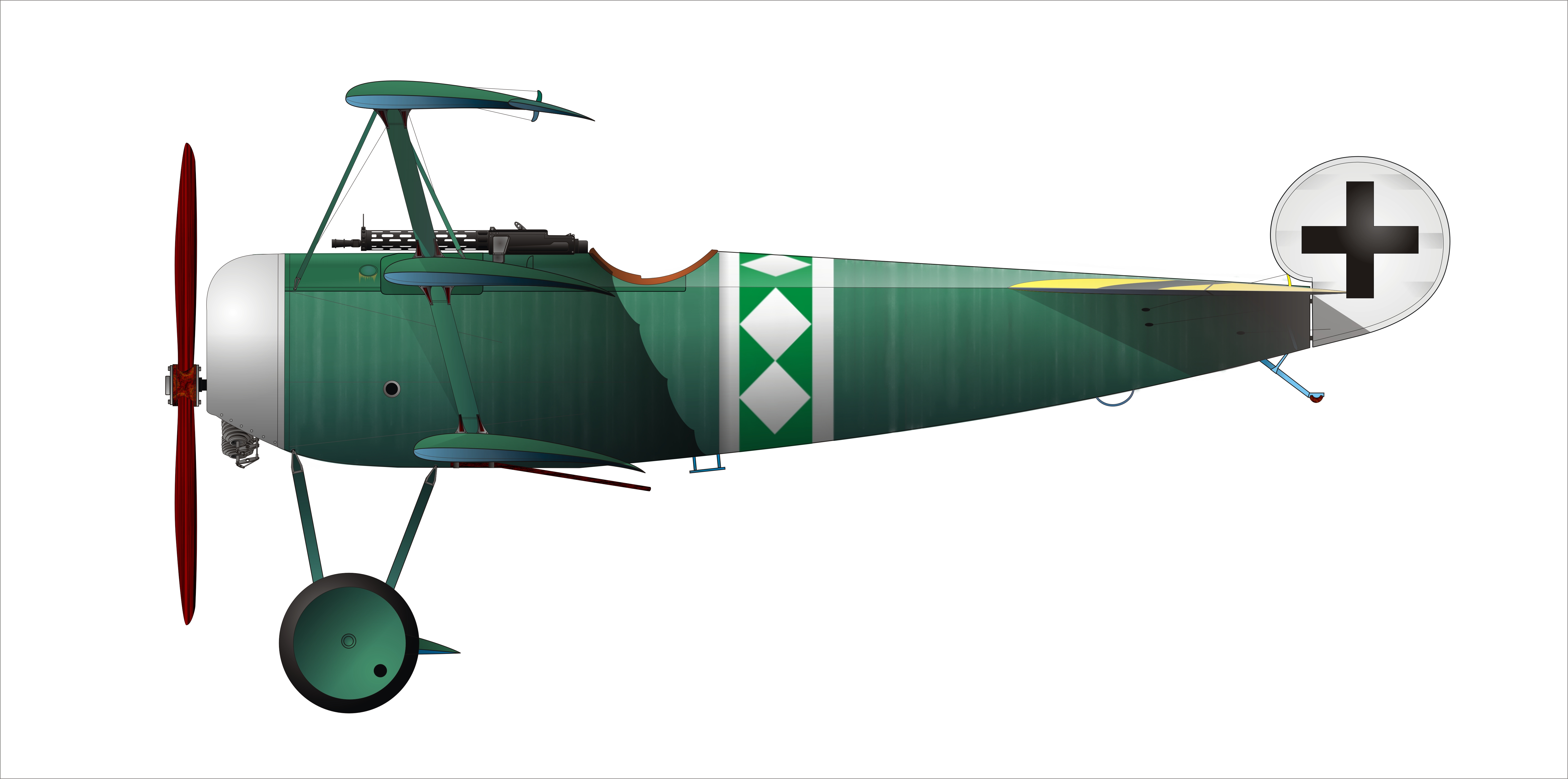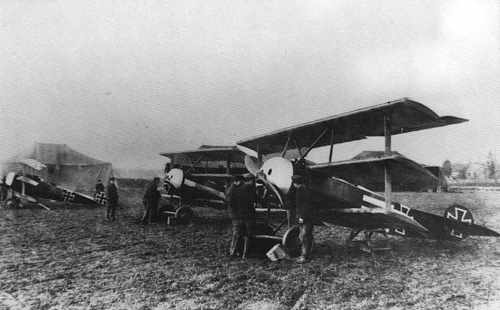|
Jasta 18
Royal Prussian Jagdstaffel 18 was a "hunting squadron" (fighter squadron) of the ''Luftstreitkräfte'', the air arm of the Imperial German Army during World War I. History The Jasta was formed on 30 October 1916, at Halluin under 4th Armee auspices; Oberleutnant Karl von Grieffenhagen transferred in from Jasta 1 to take command. It deactivated at war's end, having existed some 25 months. Personnel Jasta 18's '' Staffelfuhrer'' (also ''Jastaführer'', Commanding officers) were: # Oberleutnant Karl von Grieffenhagen: 30 October 1916 – 12 August 1917 # Oberleutnant Rudolf Berthold: 12 August 1917 – 10 October 1917 # Oberleutnant Ernst Turck: 10 October 1917 – March 1918 # Leutnant der Reserve August Raben: 14 March 1918 – November 1918 A dozen flying aces served within its ranks, including Berthold, Hans Müller, Walter von Bülow-Bothkamp, Wilhelm Kühne, Paul Strähle, Harald Auffarth, Joseph Veltjens, and Johannes Klein. After Raben took command, aces such as Wilhelm ... [...More Info...] [...Related Items...] OR: [Wikipedia] [Google] [Baidu] |
German Empire
The German Empire (),Herbert Tuttle wrote in September 1881 that the term "Reich" does not literally connote an empire as has been commonly assumed by English-speaking people. The term literally denotes an empire – particularly a hereditary empire led by an emperor, although has been used in German to denote the Roman Empire because it had a weak hereditary tradition. In the case of the German Empire, the official name was , which is properly translated as "German Empire" because the official position of head of state in the constitution of the German Empire was officially a "presidency" of a confederation of German states led by the King of Prussia who would assume "the title of German Emperor" as referring to the German people, but was not emperor of Germany as in an emperor of a state. –The German Empire" ''Harper's New Monthly Magazine''. vol. 63, issue 376, pp. 591–603; here p. 593. also referred to as Imperial Germany, the Second Reich, as well as simply Germany, ... [...More Info...] [...Related Items...] OR: [Wikipedia] [Google] [Baidu] |
Paul Strähle
''Leutnant'' Paul Strähle was a German World War I flying ace credited with 15 aerial victories.The Aerodrome website page on StrählRetrieved 27 January 2010. Early life and infantry service Paul Strähle was born on 20 May 1893 in Schorndorf, Kingdom of Wurttemberg''Above the Lines: The Aces and Fighter Units of the German Air Service, Naval Air Service and Flanders Marine Corps, 1914–1918'', pp. 212-213 He originally served in the infantry after joining the German army on 1 October 1913. He transferred to aviation and was appointed to pilot training in 1915. He first flew in an artillery cooperation unit, being posted to ''Flieger-Abteilung (Artillerie) 213'' on 15 July 1916. Beginning 5 September, he trained on fighters. Service as a fighter pilot He was then assigned to ''Jagdstaffel 18'' on 27 October 1916. He scored his first aerial victory on 14 February 1917, shooting down a Royal Aircraft Factory F.E.2b; his victim is believed to have been Harold Hartney. He con ... [...More Info...] [...Related Items...] OR: [Wikipedia] [Google] [Baidu] |
Jagdstaffel 15
Royal Prussian Jagdstaffel 15, commonly abbreviated to Jasta 15, was a "hunting group" (i.e., fighter squadron) of the ''Luftstreitkräfte'', the air arm of the Imperial German Army during World War I. The unit would score over 150 aerial victories during the war, at the expense of seven killed in action, two killed in flying accidents, three wounded in action, one injured in a flying accident, and two taken prisoner of war. History The "Jasta" was formed on 28 September 1916 at Rixheim, from Kampfeinsitzer Kommando Habsheim, FFA 48 and FFA 68. It mobilized on 9 October 1916. Three days later, it flew an interception mission against French and British bombers targeting Oberdorf's Mauser factory and destroyed three of them. For the next few months, the jasta achieved desultory results against French Nieuports and Caudrons. However, the ascension of Heinrich Gontermann to command in April 1917 changed that. The balloon buster ace arrived with 17 victories to this credit; in ... [...More Info...] [...Related Items...] OR: [Wikipedia] [Google] [Baidu] |
Jagdstaffel 13
Royal Prussian Jagdstaffel 13 was a World War I "hunting group" (i.e., fighter squadron) of the ''Luftstreitkräfte'', the air arm of the Imperial German Army during World War I. The unit would score 108 aerial victories during the war, at the expense of twelve killed in action, one killed in a flying accident, two wounded in action, and two taken prisoner of war. History Jasta 13 was formed on 16 September 1916. Its founding personnel came from the Fokkerstaffel attached to FFA 9, and from other aviation units in the area of Armee-Abteilung C, ''Armee-Abteilung'' C. They were operational by 15 October 1916. However, Jasta 13 did not score its first victory until 22 January 1917. In Spring 1917, the squadron was assigned to support of 7th Army (German Empire), 7th Armee. By the end of August 1917, the unit had been credited with about ten victories. In September, it joined Jagdgruppe von Braun, along with Jagdstaffel 14, Jasta 14, Jasta 16, Jasta 21, Jasta 22, Jasta 23, Jasta 32, ... [...More Info...] [...Related Items...] OR: [Wikipedia] [Google] [Baidu] |
Jagdstaffel 12
Royal Prussian Jagdstaffel 12 was a World War I "hunting group" (i.e., fighter squadron) of the ''Luftstreitkräfte'', the air arm of the Imperial German Army during World War I. As one of the original German fighter squadrons, the unit would score 155 aerial victories (including three wins over observation balloons) during the war, at the expense of seventeen killed in action, eight wounded in action, and one taken prisoner of war. History Royal Prussian Jagdstaffel 12 was created on 28 September 1916 from an existing ad hoc unit, Fokkerstaffel West. The new squadron mobilized on 12 October 1916 at Laon, France. It scored its first victory on 4 December 1916. The squadron was initially equipped with ill-performing Fokker D.Is. On 24 March 1917, the unit was credited with its tenth victory. The following month, Bloody April 1917, Jasta 12 downed 23 Royal Flying Corps aircraft. May saw 10 more victories. By the end of July, the jasta's scoreboard showed 74 victories. When it lost ... [...More Info...] [...Related Items...] OR: [Wikipedia] [Google] [Baidu] |
Jagdgeschwader II
''Jagdgeschwader II (Fighter Wing II, or JG II)'' was the Imperial German Air Service's second fighter wing. Established because of the great success of Manfred von Richthofen's preceding '' Jagdgeschwader I'' wing, ''Jagdgeschwader II'' and ''Jagdgeschwader III'' were founded on 2 February 1918. JG II was assigned four squadrons nominally equipped with 14 aircraft each. The new wing was supposed to be fully operational in time for an offensive slated for 21 March 1918. Named to raise and lead it was 23-victory flying ace ''Hauptmann'' Adolf von Tutschek. However, he was killed in action on 15 March 1918. His hasty replacement was 28-victory ace ''Hauptmann'' Rudolf Berthold. Grounded by wounds that rendered him narcotic-dependent, the ''Pour le Merite'' winner nevertheless firmly took charge. Under his leadership, JG II advanced 40 miles (64 kilometers) behind the German offensive. As the ground fighting stalled in early April, air fighting above it intensified. Then, on the nig ... [...More Info...] [...Related Items...] OR: [Wikipedia] [Google] [Baidu] |
6th Army (German Empire)
The 6th Army (german: 6. Armee / Armeeoberkommando 6 / A.O.K. 6) was an army level command of the German Army in World War I. It was formed on mobilization in August 1914 from the IV Army Inspectorate. The army was disbanded in 1919 during demobilization after the war. History At the outbreak of World War I, command of the army was given to Rupprecht, Crown Prince of Bavaria (''Kronprinz Rupprecht von Bayern''). The 6th Army initially consisted of the units of the Bavarian Army (which had retained military sovereignty after the unification of Germany), with some additional Prussian units. During the execution of Plan XVII, the 6th Army was stationed in the Central sector, covering Lorraine. In August 1914, in the Battle of Lorraine, Rupprecht's 6th Army managed to hold against the French offensive, using a feigned withdrawal to lure the advancing armies onto prepared defensive positions. After the Western Front turned to stalemate and the opposing forces formed lines o ... [...More Info...] [...Related Items...] OR: [Wikipedia] [Google] [Baidu] |
Avelin
Avelin () is a commune in the Nord department in northern France. It is south of the centre of Lille. The village's name is of Germanic origin. Population Heraldry See also *Communes of the Nord department The following is a list of the 648 communes of the Nord department of the French Republic. The communes cooperate in the following intercommunalities (as of 2020):Communes of Nord (French department) French Flanders {{Nord-geo-stub ... [...More Info...] [...Related Items...] OR: [Wikipedia] [Google] [Baidu] |
Harlebeke
Harelbeke (; vls, Oarlbeke) is a city and municipality located in the Belgian province of West Flanders. The municipality comprises the city of Harelbeke proper and the towns of Bavikhove and Hulste. On January 1, 2019, Harelbeke had a total population of 28,447. The total area is 29.14 km² which gives a population density of 898 inhabitants per km². Inhabitants consider their hometown to be a "Weireldstad" (metropolis), which also led to a monthly "Harelbekedag" amongst the students of Harelbeke studying in Ghent. In Harelbeke a museum remembers the life and work of musician and composer Peter Benoit, called the Peter Benoit Huis. Famous natives * Andreas Pevernage (1542/1543 – 1591), composer of the late Renaissance * Jacobus Vaet (1529-1567), Renaissance composer, possibly born in Harelbeke * Armand Coeck (1941 - ), avant-garde composer * Jan Bucquoy (1945 - ), anarchist and film-maker (''Camping Cosmos'') * Peter Benoit, composer * Wim Opbrouck, actor and singer Har ... [...More Info...] [...Related Items...] OR: [Wikipedia] [Google] [Baidu] |
Western Front (World War I)
The Western Front was one of the main theatres of war during the First World War. Following the outbreak of war in August 1914, the German Army opened the Western Front by invading Luxembourg and Belgium, then gaining military control of important industrial regions in France. The German advance was halted with the Battle of the Marne. Following the Race to the Sea, both sides dug in along a meandering line of fortified trenches, stretching from the North Sea to the Swiss frontier with France, which changed little except during early 1917 and in 1918. Between 1915 and 1917 there were several offensives along this front. The attacks employed massive artillery bombardments and massed infantry advances. Entrenchments, machine gun emplacements, barbed wire and artillery repeatedly inflicted severe casualties during attacks and counter-attacks and no significant advances were made. Among the most costly of these offensives were the Battle of Verdun, in 1916, with a combined 700,000 ... [...More Info...] [...Related Items...] OR: [Wikipedia] [Google] [Baidu] |
Kurt Adolf Monnington
Leutnant Kurt Adolf Monnington (1891–1939) was a World War I flying ace credited with eight aerial victories. Biography Kurt Adolf Monnington was born on 29 September 1891 in Hamburg, the German Empire. The Aerodrome website's page on Monnington. His original service during World War I was with the German ground forces. He won an Second Class on 14 June 1915.Franks et al 1993, pp. 168-169. Monnington began his aviation career with a two-seater unit, ''Flieger-Abteilung'' (Flier Detachment) 62. After that seasoning, he was reassigned as a fighter pil ... [...More Info...] [...Related Items...] OR: [Wikipedia] [Google] [Baidu] |




